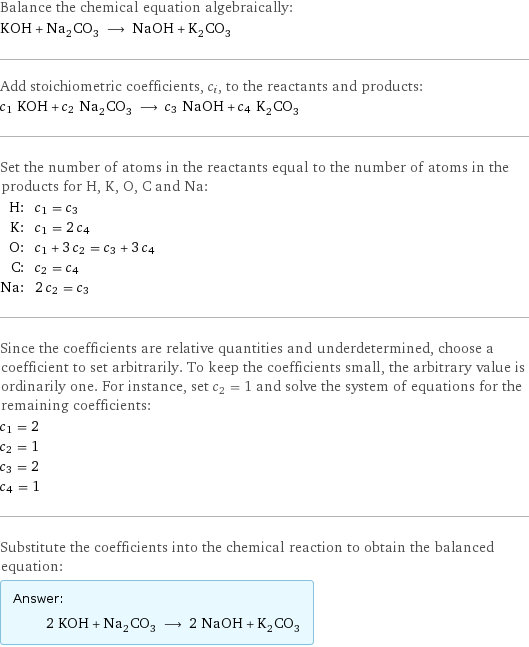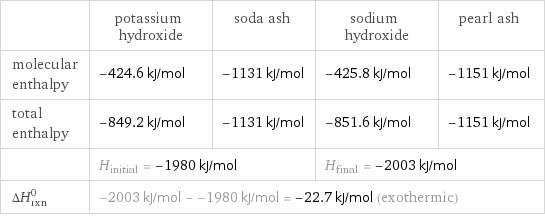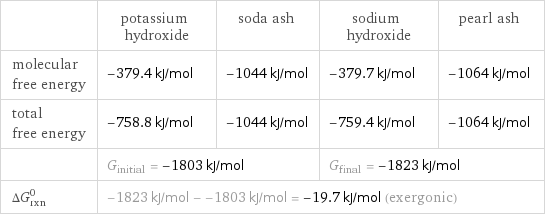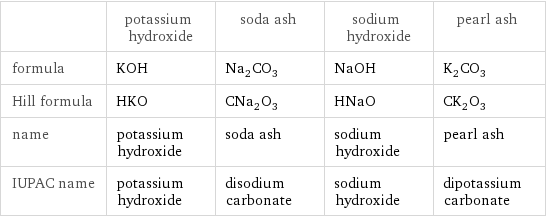Input interpretation

KOH potassium hydroxide + Na_2CO_3 soda ash ⟶ NaOH sodium hydroxide + K_2CO_3 pearl ash
Balanced equation

Balance the chemical equation algebraically: KOH + Na_2CO_3 ⟶ NaOH + K_2CO_3 Add stoichiometric coefficients, c_i, to the reactants and products: c_1 KOH + c_2 Na_2CO_3 ⟶ c_3 NaOH + c_4 K_2CO_3 Set the number of atoms in the reactants equal to the number of atoms in the products for H, K, O, C and Na: H: | c_1 = c_3 K: | c_1 = 2 c_4 O: | c_1 + 3 c_2 = c_3 + 3 c_4 C: | c_2 = c_4 Na: | 2 c_2 = c_3 Since the coefficients are relative quantities and underdetermined, choose a coefficient to set arbitrarily. To keep the coefficients small, the arbitrary value is ordinarily one. For instance, set c_2 = 1 and solve the system of equations for the remaining coefficients: c_1 = 2 c_2 = 1 c_3 = 2 c_4 = 1 Substitute the coefficients into the chemical reaction to obtain the balanced equation: Answer: | | 2 KOH + Na_2CO_3 ⟶ 2 NaOH + K_2CO_3
Structures

+ ⟶ +
Names

potassium hydroxide + soda ash ⟶ sodium hydroxide + pearl ash
Reaction thermodynamics
Enthalpy

| potassium hydroxide | soda ash | sodium hydroxide | pearl ash molecular enthalpy | -424.6 kJ/mol | -1131 kJ/mol | -425.8 kJ/mol | -1151 kJ/mol total enthalpy | -849.2 kJ/mol | -1131 kJ/mol | -851.6 kJ/mol | -1151 kJ/mol | H_initial = -1980 kJ/mol | | H_final = -2003 kJ/mol | ΔH_rxn^0 | -2003 kJ/mol - -1980 kJ/mol = -22.7 kJ/mol (exothermic) | | |
Gibbs free energy

| potassium hydroxide | soda ash | sodium hydroxide | pearl ash molecular free energy | -379.4 kJ/mol | -1044 kJ/mol | -379.7 kJ/mol | -1064 kJ/mol total free energy | -758.8 kJ/mol | -1044 kJ/mol | -759.4 kJ/mol | -1064 kJ/mol | G_initial = -1803 kJ/mol | | G_final = -1823 kJ/mol | ΔG_rxn^0 | -1823 kJ/mol - -1803 kJ/mol = -19.7 kJ/mol (exergonic) | | |
Equilibrium constant
![Construct the equilibrium constant, K, expression for: KOH + Na_2CO_3 ⟶ NaOH + K_2CO_3 Plan: • Balance the chemical equation. • Determine the stoichiometric numbers. • Assemble the activity expression for each chemical species. • Use the activity expressions to build the equilibrium constant expression. Write the balanced chemical equation: 2 KOH + Na_2CO_3 ⟶ 2 NaOH + K_2CO_3 Assign stoichiometric numbers, ν_i, using the stoichiometric coefficients, c_i, from the balanced chemical equation in the following manner: ν_i = -c_i for reactants and ν_i = c_i for products: chemical species | c_i | ν_i KOH | 2 | -2 Na_2CO_3 | 1 | -1 NaOH | 2 | 2 K_2CO_3 | 1 | 1 Assemble the activity expressions accounting for the state of matter and ν_i: chemical species | c_i | ν_i | activity expression KOH | 2 | -2 | ([KOH])^(-2) Na_2CO_3 | 1 | -1 | ([Na2CO3])^(-1) NaOH | 2 | 2 | ([NaOH])^2 K_2CO_3 | 1 | 1 | [K2CO3] The equilibrium constant symbol in the concentration basis is: K_c Mulitply the activity expressions to arrive at the K_c expression: Answer: | | K_c = ([KOH])^(-2) ([Na2CO3])^(-1) ([NaOH])^2 [K2CO3] = (([NaOH])^2 [K2CO3])/(([KOH])^2 [Na2CO3])](../image_source/bc329d5a55397edcd813660132dfed33.png)
Construct the equilibrium constant, K, expression for: KOH + Na_2CO_3 ⟶ NaOH + K_2CO_3 Plan: • Balance the chemical equation. • Determine the stoichiometric numbers. • Assemble the activity expression for each chemical species. • Use the activity expressions to build the equilibrium constant expression. Write the balanced chemical equation: 2 KOH + Na_2CO_3 ⟶ 2 NaOH + K_2CO_3 Assign stoichiometric numbers, ν_i, using the stoichiometric coefficients, c_i, from the balanced chemical equation in the following manner: ν_i = -c_i for reactants and ν_i = c_i for products: chemical species | c_i | ν_i KOH | 2 | -2 Na_2CO_3 | 1 | -1 NaOH | 2 | 2 K_2CO_3 | 1 | 1 Assemble the activity expressions accounting for the state of matter and ν_i: chemical species | c_i | ν_i | activity expression KOH | 2 | -2 | ([KOH])^(-2) Na_2CO_3 | 1 | -1 | ([Na2CO3])^(-1) NaOH | 2 | 2 | ([NaOH])^2 K_2CO_3 | 1 | 1 | [K2CO3] The equilibrium constant symbol in the concentration basis is: K_c Mulitply the activity expressions to arrive at the K_c expression: Answer: | | K_c = ([KOH])^(-2) ([Na2CO3])^(-1) ([NaOH])^2 [K2CO3] = (([NaOH])^2 [K2CO3])/(([KOH])^2 [Na2CO3])
Rate of reaction
![Construct the rate of reaction expression for: KOH + Na_2CO_3 ⟶ NaOH + K_2CO_3 Plan: • Balance the chemical equation. • Determine the stoichiometric numbers. • Assemble the rate term for each chemical species. • Write the rate of reaction expression. Write the balanced chemical equation: 2 KOH + Na_2CO_3 ⟶ 2 NaOH + K_2CO_3 Assign stoichiometric numbers, ν_i, using the stoichiometric coefficients, c_i, from the balanced chemical equation in the following manner: ν_i = -c_i for reactants and ν_i = c_i for products: chemical species | c_i | ν_i KOH | 2 | -2 Na_2CO_3 | 1 | -1 NaOH | 2 | 2 K_2CO_3 | 1 | 1 The rate term for each chemical species, B_i, is 1/ν_i(Δ[B_i])/(Δt) where [B_i] is the amount concentration and t is time: chemical species | c_i | ν_i | rate term KOH | 2 | -2 | -1/2 (Δ[KOH])/(Δt) Na_2CO_3 | 1 | -1 | -(Δ[Na2CO3])/(Δt) NaOH | 2 | 2 | 1/2 (Δ[NaOH])/(Δt) K_2CO_3 | 1 | 1 | (Δ[K2CO3])/(Δt) (for infinitesimal rate of change, replace Δ with d) Set the rate terms equal to each other to arrive at the rate expression: Answer: | | rate = -1/2 (Δ[KOH])/(Δt) = -(Δ[Na2CO3])/(Δt) = 1/2 (Δ[NaOH])/(Δt) = (Δ[K2CO3])/(Δt) (assuming constant volume and no accumulation of intermediates or side products)](../image_source/8057329c37650b6e5f24d5b06167843f.png)
Construct the rate of reaction expression for: KOH + Na_2CO_3 ⟶ NaOH + K_2CO_3 Plan: • Balance the chemical equation. • Determine the stoichiometric numbers. • Assemble the rate term for each chemical species. • Write the rate of reaction expression. Write the balanced chemical equation: 2 KOH + Na_2CO_3 ⟶ 2 NaOH + K_2CO_3 Assign stoichiometric numbers, ν_i, using the stoichiometric coefficients, c_i, from the balanced chemical equation in the following manner: ν_i = -c_i for reactants and ν_i = c_i for products: chemical species | c_i | ν_i KOH | 2 | -2 Na_2CO_3 | 1 | -1 NaOH | 2 | 2 K_2CO_3 | 1 | 1 The rate term for each chemical species, B_i, is 1/ν_i(Δ[B_i])/(Δt) where [B_i] is the amount concentration and t is time: chemical species | c_i | ν_i | rate term KOH | 2 | -2 | -1/2 (Δ[KOH])/(Δt) Na_2CO_3 | 1 | -1 | -(Δ[Na2CO3])/(Δt) NaOH | 2 | 2 | 1/2 (Δ[NaOH])/(Δt) K_2CO_3 | 1 | 1 | (Δ[K2CO3])/(Δt) (for infinitesimal rate of change, replace Δ with d) Set the rate terms equal to each other to arrive at the rate expression: Answer: | | rate = -1/2 (Δ[KOH])/(Δt) = -(Δ[Na2CO3])/(Δt) = 1/2 (Δ[NaOH])/(Δt) = (Δ[K2CO3])/(Δt) (assuming constant volume and no accumulation of intermediates or side products)
Chemical names and formulas

| potassium hydroxide | soda ash | sodium hydroxide | pearl ash formula | KOH | Na_2CO_3 | NaOH | K_2CO_3 Hill formula | HKO | CNa_2O_3 | HNaO | CK_2O_3 name | potassium hydroxide | soda ash | sodium hydroxide | pearl ash IUPAC name | potassium hydroxide | disodium carbonate | sodium hydroxide | dipotassium carbonate
Substance properties

| potassium hydroxide | soda ash | sodium hydroxide | pearl ash molar mass | 56.105 g/mol | 105.99 g/mol | 39.997 g/mol | 138.2 g/mol phase | solid (at STP) | solid (at STP) | solid (at STP) | solid (at STP) melting point | 406 °C | 851 °C | 323 °C | 891 °C boiling point | 1327 °C | 1600 °C | 1390 °C | density | 2.044 g/cm^3 | | 2.13 g/cm^3 | 2.43 g/cm^3 solubility in water | soluble | soluble | soluble | soluble surface tension | | | 0.07435 N/m | dynamic viscosity | 0.001 Pa s (at 550 °C) | 0.00355 Pa s (at 900 °C) | 0.004 Pa s (at 350 °C) |
Units
